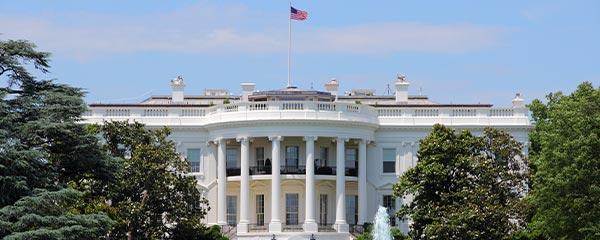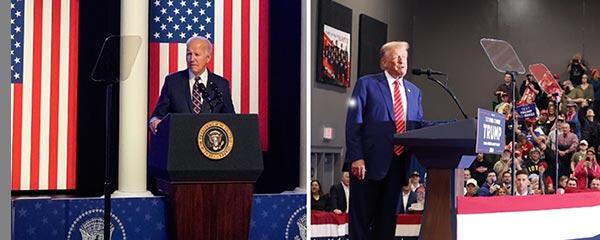Story Highlights
- 43% identified as independents in 2023, tying 2014 record
- Record-low 27% identify as Democrats, tying Republicans
- Republicans maintain slight edge in leaned party identification
- Ideological identification steady; conservatives, moderates largest groups
WASHINGTON, D.C. -- Political independents continue to constitute the largest political bloc in the U.S., with an average of 43% of U.S. adults identifying this way in 2023, tying the record high from 2014. Independent identification has been 40% or higher each year since 2011, except for the 2016 (39%) and 2020 (39%) presidential election years. Equal 27% shares of U.S. adults identify as Republicans and Democrats, with the Democratic figure marking a new low for that party in Gallup’s trend.
Independents first outnumbered supporters of both major political parties in 1991 and have continued to do so since then, except in several years between 2004 and 2008. Over time, the increase in the percentage of independents has come more at the expense of Democrats than Republicans, which might be expected since Democrats were previously the largest political group.
Gallup asks respondents in each survey whether they identify politically as a Republican, a Democrat or an independent. The results reported here are based on combined data for each year, including interviews with more than 12,000 U.S. adults in 2023.
Independent identification was up two percentage points in 2023 compared with 2022, while there was a one-point decline in both Democratic and Republican identification.
Democratic identification has now declined by one point in each of the past three years. These declines, and the new low registered in 2023, are likely tied to President Joe Biden’s unpopularity. Biden’s job approval ratings have largely been around 40% since late 2021, and were consistently below that mark in October, November and December.
The record low for Republican identification was 25% in 2013.
Independent Leanings Give Republicans a Slight Edge in Party Preferences
All Gallup survey respondents who identify as independents are then asked whether they lean more toward the Republican Party or the Democratic Party. Last year, slightly more independents leaned Republican than leaned Democratic. As a result, a combined 45% of U.S. adults identify as Republicans or lean toward the GOP, while 43% are Democrats or Democratic leaners.
The 2023 figures are similar to those from 2022, when Republicans had a one-point advantage (45% to 44%). Republican advantages have been rare since Gallup first began measuring independent political leanings on a regular basis in 1991. In fact, 2023 is just the third time Republicans have had even a slight edge, along with 1991 and 2022.
In most years, there have been more Democrats and Democratic leaners than Republicans and Republican leaners, though the two partisan groups were tied in 2002, 2003 and 2011.
Conservatives, Moderates Tie for Top Ideological Identification
In addition to measuring their affiliation with either of the major political parties, Gallup asks Americans in each survey to describe their political views on a liberal to conservative spectrum. In 2023, on average, 36% of U.S. adults described their political views as conservative, 36% as moderate and 25% as liberal. Ideological identification has changed little in recent years; the latest figures essentially match the averages over the past 10 years.
From a longer-term perspective, the notable change has been the increase in liberal identification, which was under 20% from 1992 to 2000 and in 2002 and 2004. Both conservative and moderate identification have dipped slightly over the past two decades, but there has been a larger drop for moderates than conservatives since the trend began -- moderates were the biggest group from 1992 to 2002.
As Gallup has previously documented, the increase in liberal identification reflects big shifts in how Democrats describe their political views. Last year, 53% of Democrats identified as liberal, 35% as moderate and 11% as conservative. While similar to the level in 2022, the 53% liberal figure is up from 43% in 2013, 32% in 2003 and 25% in 1994 (the first year Gallup analyzed ideology by party identification).
Nearly three-quarters of Republicans, 73% (essentially unchanged from 2022, but also up long term), describe themselves as conservative, with most of the rest, 22%, saying they are moderate.
Following the normal pattern for independents, the plurality of this group, 48%, identify as political moderates, while 30% are conservatives and 20% liberals.
Implications
As 2024 begins, the parties are closely matched based on political party identification and leanings. However, Democrats are clearly in a weaker position than they have been in any recent election year. This is based on the new low percentage of U.S. adults identifying as Democrats, as well as the Republican advantage in leaned party identification. In the past four presidential election years, Democrats had at least a five-point advantage in leaned party identification. They won the popular vote each of those years, though Republican Donald Trump won the 2016 election based on the Electoral College vote.
This presidential election year is likely to see a drop in the percentage of political independents, as has occurred in six of the past seven presidential election years (all but 2012), amid intense focus on national politics and the two major parties. Still, even with a slight election-year drop -- which has ranged from two to five points -- independents will remain the largest, and arguably most persuadable, group of voters. In what is expected to be a close election contest, it is critical for each party, but especially Democrats, to nominate a candidate who can appeal to independent voters.
To stay up to date with the latest Gallup News insights and updates, follow us on X.
Learn more about how the Gallup Poll Social Series works.




